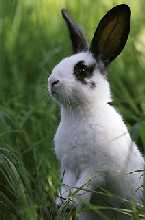| |
Incidence of spontaneous cataracts in laboratory rabbits
 |
 Picture: © Bayer Animal Health Picture: © Bayer Animal Health
|
 |
Spontaneous cataracts are commonly seen in rabbits in the daily practice. In this study, nearly 1000 laboratory rabbits were examined to document the occurrence and incidence of spontaneously occurring cataracts in older New Zealand White (NZW) and New Zealand White New Zealand Red (NZW NZR - F1) rabbits during prescreening examinations at Alcon Laboratories.
|
 |
 |
|  |
A total of 946 rabbits (670 NZW and 276 NZW NZR) ranging in age from 77 to 288 days were examined.
Of the NZW rabbits, 333 were males and 337 were females. Of the NZW NZR (F1) rabbits, 139 were males and 137 were females.
Thirty-eight NZW rabbits (23 males and 15 females) exhibited immature cataracts in one or both eyes, and three NZW NZR (F1) rabbits (one male and two females) exhibited cataracts in one or both eyes.
The overall incidence of cataracts was 4.3% of all rabbits. Males and females were equally affected, but a significant difference in the incidence of cataracts existed between the NZW and NZW NZR (F1) rabbits with 5.7% of the NZW rabbits affected and 1.1% of the NZW NZR (F1) rabbits affected.
Spontaneous juvenile cataracts occur in rabbits and may develop as incidental lesions during toxicologic studies. The incidence of cataracts noted in our studies is consistent with an autosomal recessive mode of inheritance, but further studies are needed to confirm the mode or modes of inheritance. Hybrid pigmented rabbits (F1 or NZW NZR) exhibited a significantly lower incidence of cataracts.
Source: Munger, Robert J., Langevin, Nicholas & Podval, J. (2002): Spontaneous cataracts in laboratory rabbits. In: Veterinary Ophthalmology 5 (3), 177-181.
Tell a friend
|
Print version
|
Send this article
|
|  |

Metastasis of a well differentiated perianal gland tumorPunica granatum associated with hepatotoxicosis in cattle Toceranib phosphate (Palladia®) in canine gastrointestinal stromal tumors Toceranib phosphate (Palladia®) in canine gastrointestinal stromal tumors Radioactive iodine uptake in hyperthyroid cats after rh-TSH Radioactive iodine uptake in hyperthyroid cats after rh-TSH Hypoechoic tissue changes in dogs with malignant prostatic lymphoma Hypoechoic tissue changes in dogs with malignant prostatic lymphoma Emphysematous gastritis in dogs and cats Emphysematous gastritis in dogs and cats Primary pulmonary histiocytic sarcoma in dogs Primary pulmonary histiocytic sarcoma in dogs Determining prognosis in canine sepsis Determining prognosis in canine sepsis  Correlation of plasma and tear glucose, creatinine and urea nitrogen in cats Correlation of plasma and tear glucose, creatinine and urea nitrogen in cats Perineal hernias in dogs - always a bilateral problem? Perineal hernias in dogs - always a bilateral problem? Pharmacokinetic of gabapentin in cats Pharmacokinetic of gabapentin in cats Follicular development of canine ovaries stimulated by eCG plus hCG Follicular development of canine ovaries stimulated by eCG plus hCG
|














